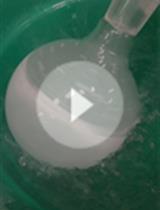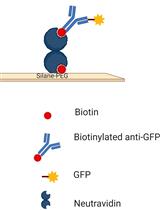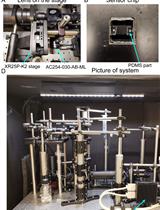- EN - English
- CN - 中文
Conjugation of Fab’ Fragments with Fluorescent Dyes for Single-molecule Tracking on Live Cells
Fab片段结合荧光染料用于活细胞单分子示踪
发布: 2019年09月20日第9卷第18期 DOI: 10.21769/BioProtoc.3375 浏览次数: 7944
评审: Imre GáspárShalini Low-NamTrinadh Venkata Satish TammanaWoojong Lee
Abstract
Our understanding of the regulation and functions of cell-surface proteins has progressed rapidly with the advent of advanced optical imaging techniques. In particular, single-molecule tracking (SMT) using bright fluorophores conjugated to antibodies and wide-field microscopy methods such as total internal reflection fluorescence microscopy have become valuable tools to discern how endogenous proteins control cell biology. Yet, some technical challenges remain; in SMT, these revolve around the characteristics of the labeling reagent. A good reagent should have neutrality (in terms of not affecting the target protein’s functions), tagging specificity, and a bright fluorescence signal. In addition, a long shelf-life is desirable due to the time and monetary costs associated with reagent preparation. Semiconductor-based quantum dots (Qdots) or Janelia Fluor (JF) dyes are bright and photostable, and are thus excellent candidates for SMT tagging. Neutral, high-affinity antibodies can selectively bind to target proteins. However, the bivalency of antibodies can cause simultaneous binding to two proteins, and this bridging effect can alter protein functions and behaviors. Bivalency can be avoided using monovalent Fab fragments generated by enzymatic digestion of neutral antibodies. However, conjugation of a Fab with a dye using the chemical cross-linking agent SMCC (succinimidyl 4-(N-maleimidomethyl)cyclohexane-1-carboxylate) requires reduction of the interchain disulfide bond within the Fab fragment, which can decrease the structural stability of the Fab and weaken its antigen-binding capability. To overcome this problem, we perform limited reduction of F(ab’)2 to generate Fab’ fragments using a weak reducer, cysteamine, which yields free sulfhydryl groups in the hinge region, while the interchain disulfide bond in Fab’ is intact. Here, we describe a method that generates Fab’ with high yield from two isoforms of IgG and conjugates the Fab’ fragments with Qdots. This conjugation scheme can be applied easily to other types of dyes with similar chemical characteristics.
Keywords: Single-molecule tracking (单分子示踪)Background
Cell-surface protein functions are tightly regulated in their native environment. Gaining a comprehensive understanding of their functions necessitates monitoring their interactions with various cell membrane components, such as other proteins and lipids, and cytoskeletal machinery and cellular organelles below the membranes. Optical tools enabling live-cell based imaging at a molecular level (Joo et al., 2008; Lord et al., 2010; Chung, 2017) include conventional methods such as confocal microscopy and total internal reflection fluorescence microscopy (TIRFM) combined with specific modalities such as Förster resonance energy transfer (FRET) (Sekar and Periasamy, 2003), single-molecule tracking (SMT) (Moerner, 2012), and fluorescence correlation spectroscopy (FCS) (Kim et al., 2007), and cutting-edge super-resolution microscopy, such as photoactivated localization microscopy (PALM) (Betzig et al., 2006), stochastic optical reconstruction microscopy (STORM) (Rust et al., 2006), stimulated emission depletion (STED) microscopy (Hein et al., 2008), structured illumination microscopy (SIM) (Gustafsson, 2000 and Gustafsson et al., 2009), and lattice light sheet (LLS) microscopy (Chen et al., 2014). Using these tools for live-cell imaging to monitor endogenous proteins requires bright fluorophore-coupled reagents that specifically bind to target proteins. To this end, bright dyes such as semiconductor quantum dots (Qdots) (Dahan et al., 2003; Chung and Bawendi, 2004; Lidke et al., 2004; Chung et al., 2010; Bien-Ly et al., 2014; Chung and Mellman, 2015; Chung et al., 2016) and Janelia Fluor (JF) dyes (Grimm et al., 2015 and 2017) conjugated to high-affinity and non-perturbing antibody-based reagents are widely used. However, an antibody can bind to two target proteins simultaneously. This problem is typically circumvented by digesting antibodies to Fab fragments using proteolytic enzymes such as papain, which cleaves at the hinge region of immunoglobulins (Chung et al., 2010; Bien-Ly et al., 2014; Chung and Mellman, 2015; Chung et al., 2016). Conjugation of Fab with fluorescent dyes relies on a thiol-maleimide reaction. This reaction, however, can destabilize Fab when the interchain disulfide bond within a Fab is reduced, which elicits loss of binding capability to target proteins within a relatively short period of time (a few weeks at best). Consequently, laboratories must frequently regenerate the conjugates, imposing higher cost and hours lost. Thus, we use Fab’ fragments containing free sulfhydryl groups in the hinge region (Selis et al., 2016), which can be used for a succinimidyl 4-(N-maleimidomethyl) cyclohexane-1-carboxylate (SMCC)-based conjugation reaction without reducing the interchain disulfide bond within Fab’. To this end, we perform two-step reactions, in which IgG is digested into F(ab’)2 by pepsin and Fab’ is generated by limited reduction of F(ab’)2 using cysteamine. In this protocol, we showcase a method that generates Fab’ fragments from two different types of antibodies and subsequently conjugates one type of Fab’ with quantum dots (Qdots) to monitor EGFR on live cells using SMT. We believe this conjugation scheme will most likely improve the overall yield and stability of the tagging reagents for various types of live-cell imaging of endogenous proteins.
Materials and Reagents
- Pipette tips (Olympus, catalog numbers: 24-120RL, 24-150RL, 24-165RL)
- Sterile pipette tips (Olympus, catalog numbers: 24-401, 24-404, 24-412, 24-430)
- Sterile serological pipets (Olympus, catalog numbers: 12-102, 12-104)
- 15 ml centrifuge tubes (Olympus, catalog number: 28-101)
- 50 ml centrifuge tubes (Fisher Scientific, catalog number: 14-955-239)
- 1.5 ml microcentrifuge tubes (Olympus, catalog number: 24-281)
- 1.5 ml Protein LoBind Tubes (Eppendorf, catalog number: 022431081)
- 15 ml Protein LoBind Conical Tubes (Eppendorf, catalog number: 0030122216)
- Adjustable-volume pipettes (Eppendorf, catalog number: 2231300008)
- Pierce disposable columns (Thermo Scientific, catalog number: 29920)
- NAP-5 desalting columns (GE Healthcare, catalog number: 17-0853-01)
- µ-Dish 35 mm, high glass bottom (Ibidi, catalog number: 81158)
- Treated cell culture flasks (Thermo Scientific, catalog number: 12-556-010)
- Pierce Protein Concentrators PES, 30K MWCO, 0.5 ml (Thermo Scientific, catalog number: 88502)
- Pepsin (Sigma Aldrich, catalog number: P6887-250MG)
- Mouse IgG1 Isotype Control (Invitrogen, catalog number: 02-6100); αEGFR (rat IgG2a) antibody (Abcam, catalog number: ab231)
- MDA-MB-468 breast cancer cell line (ATCC, catalog number: HTB-132)
- BCA protein assay kit (Thermo Scientific, catalog number: 23225)
- Superdex G200 (GE Healthcare, catalog number: 17-1043-01)
- Sulfo-SMCC [sulfosuccinimidyl 4-(N-maleimidomethyl) cyclohexane-1-carboxylate], No-Weigh Format (Thermo Scientific, catalog number: A39268)
- DMSO (Dimethylsulfoxide) (Thermo Scientific, catalog number: 20684)
- Qdot 605 ITK Amino (PEG) Quantum Dots (amino-PEG-Qdot605, Invitrogen, catalog number: Q21501MP) or Qdot 565 ITK Amino (PEG) Quantum Dots (amino-PEG-QDot565, Invitrogen, catalog number: Q21531MP)
- HEPES, 1 M solution, pH 7.3, molecular biology grade, ultrapure (Thermo Scientific, catalog number: J16924AE)
- Sodium chloride, 5 M (Lonza, catalog number: 51202)
- Cysteamine (Sigma-Aldrich, catalog number: M9768-5G)
- Dye labeled marker, CAL Fluor Red 610 T10 (LGC Biosearch Technologies, catalog number: RD-5082-5)
- Glycerol (Thermo Scientific, catalog number: J16374AP)
- Dulbecco's PBS (GenClone, catalog number: 25-508)
- Trypsin EDTA (Corning, catalog number: 25-052-CV)
- Pierce F(ab’)2 Preparation Kit (Thermo Scientific, catalog number: 44988, see Note 1), include:
- Zeba Spin Desalting Columns (Thermo Scientific, catalog number: 89889)
- NAb Protein A Plus Spin Columns (Thermo Scientific, catalog number: 89956)
- PBS (Thermo Scientific, catalog number: 1890535)
- Acetate buffer, pH 4.0 (Fisher Scientific, catalog number: 50-255-309)
- EDTA (Fisher Scientific, catalog number: 03-500-506)
- Cell growth medium (RPMI 1640 with 10% fetal bovine serum and 1% penicillin-streptomycin)
- RPMI 1640, with L-Glutamine, 2000 mg/L D-Glucose (GenClone, catalog number: 25-506)
- Fetal bovine serum (FBS), heat-inactivated, U.S. Origin (GenClone, catalog number: 25-514H)
- Penicillin-streptomycin mixture (Lonza, catalog number: 17-602E)
- Acetate digestion buffer, pH 4.0 (see Recipes)
- Exchange buffer, pH 7.2 (see Recipes)
Equipment
- Eppendorf easypet 3 (Eppendorf, catalog number: 4430000018)
- pH meter (Fisherbrand, Accumet, model: 15)
- Vortex mixer (VWR, model: Analog Vortex Mixer)
- Centrifuge (Eppendorf, model: 5810R)
- Thermo mixer (Thermo Scientific, model: 13687720)
- End-over-end mixer (Argos Technologies, RotoFlex, model: R2000)
- CO2 incubator air jacket TC (VWR, catalog number: 10810-902)
- Biosafety cabinet (LabConco, model: A2)
- Nikon Eclipse TE2000 inverted microscope with TIRF illuminator and a 100x/1.49NA Plan Apo objective (Nikon, model: Eclipse TE2000-E)
- iXon back-illuminated EMCCD camera (Andor Technology, catalog number: DU-888E-C00-#BV-500)
- 488 nm line of solid-state lasers (Andor Technology)
Software
- ImageJ 1.52i with Java 1.8.0_172
Procedure
文章信息
版权信息
© 2019 The Authors; exclusive licensee Bio-protocol LLC.
如何引用
Teng, I., Bu, X. and Chung, I. (2019). Conjugation of Fab’ Fragments with Fluorescent Dyes for Single-molecule Tracking on Live Cells. Bio-protocol 9(18): e3375. DOI: 10.21769/BioProtoc.3375.
分类
细胞生物学 > 细胞成像 > 活细胞成像
癌症生物学 > 癌症生物化学 > 蛋白质
生物化学 > 蛋白质 > 单分子活性 > 成像
您对这篇实验方法有问题吗?
在此处发布您的问题,我们将邀请本文作者来回答。同时,我们会将您的问题发布到Bio-protocol Exchange,以便寻求社区成员的帮助。
Share
Bluesky
X
Copy link













